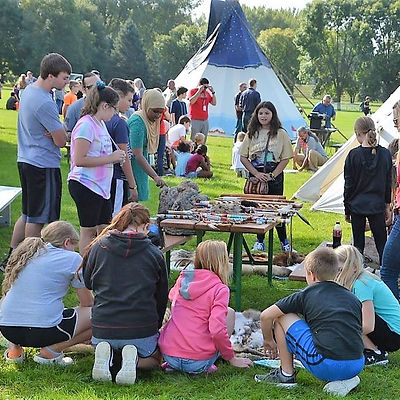
Education Day
The goal of the Mahkato Mdewakanton Dakota Education Day Committee is to work collaboratively with Mdewakanton Dakota and non-Mdewakanton Dakota communities in the design, development and implementation of cultural educational programs and activities. Such programs and activities will be designed to promote positive relationships through increased awareness and understanding of Mdewakanton Dakota and non-Mdewakanton Dakota.
Our Program

History of the Education Day
The 1862 Dakota-US Conflict in southern Minnesota resulted in the execution of 38 Dakota warriors in the largest mass execution in US History. The need for reconciliation efforts to heal wounds of the past was stressed during the 1987 Year of Reconciliation. At that time a challenge was issued by Lakota educator, writer, political activist, Vine Deloria, Jr. to create "new ceremonies" involving Dakota, non-Dakota and the land. Such ceremonies, held on a regular basis, are seen as essential to begin the building of a new shared-history.

Partnership in Education Day Program
In response to Vine Deloria, Jr's challenge in 1987, Dakota communities and Mankato District 77 have co-sponsored an educational program which provides Mankato area sixth grade children, teachers and parents the opportunity to learn about and experience southern Minnesota history and heritage. This opportunity occurs through a unique direct cultural exchange education program held each year in September in conjunction with the Mdewakanton Dakota Wacipi (dance; gathering). Mdewakanton Dakota and other tribal peoples gather in Mankato to teach the children, teachers and parents about their culture and their meanings. Over 10,000 children, teachers, assisting parents from the Mankato school district and Native American resource people, from Canada, Kansas, Iowa, Minnesota, Nebraska, North Dakota, South Dakota, and Wisconsin have come to learn and teach about various aspects of Native American culture.

Mahkato Education Day Program Design
The following is a description of the direct-cultural exchange Mahkato Education Day program which is held in conjunction with the Mdewakanton Dakota Wacipi (dance; gathering) out of doors in September at Land of Memories Park. Learning stations are located in seven (corresponding to the seven bands of the Dakota nation) camps on the perimeter of a large open circle. Each learning station is staffed with Native American resource persons who teach and demonstrate one aspect of their culture. The number of learning stations has increased from 12 (1987) to 21 (2019). Two 3-hour sessions take place. Half of the sixth grade classes, their teachers and parents come in the morning (between 300-400 persons) and the other half come in the afternoon between 300-400 persons).
The day begins with a fifteen minute "opening circle" ceremony conducted by Dakota leaders. All students, teachers and parents come together in the center of the large circle to listen and observe/participate in the Dakota way of acknowledging the Great Creator.
At the end of the opening ceremony, each class of children is directed to their assigned learning station. Groups vary from 7-12 children. For fifteen minutes, they are provided an opportunity to listen, watch, touch, try out and ask presenters questions about their craft, way of life, etc. A horn is blown to signal children and teachers to move to the next learning station in their camp a clockwise fashion. Children shake hands with each resource person when they leave the station as a way of saying "thank you." All in all children visit five different learning stations.
A variety of learning station experiences have been offered: storytelling, pipe making, moccasin making, flute making, head roach making, jewelry making, pottery making, drum making, buffalo box making, wild rice gathering, Dakota language, traditional men's regalia, men's grass dance regalia, men's dance sticks and staffs, traditional women's dance regalia and dance, women's jingle dress making and dance, women's dance shawls, star quilt making, growing and using corn, tipi living and tipi building, dream catcher making, moccasin game, children's traditional games, leather work/tanning hides, ceremonial uses of tobacco, children's games, flint knapping and tool making, drumming and songs, circle dancing, preservation of foods.
The final fifteen minute station draws all of the children back to the center into one large circle group. A Native American drum group and dancers come to the center and teach the children a circle or "friendship" dance. Everyone joins hands and dances in a circle until they get to the exit opening where all of the dancers shake hands with each one of the school participants. They disperse to their individual buses and return to school.

Program Outcomes
According to the feedback received from children, teachers, parents and resource persons over the last 20 years, this mutually created and shared experience has been meaningful on both a personal as well as professional level for many. There is a stronger sense of community developing between the Dakota communities and the Mankato community with the implementation of this program, one that seems to be uniting persons in a spirit of respect, and appreciation for each other. The collaborative efforts of both communities has created possibilities for new positive shared-histories to develop, histories that will hopefully influence and guide future generations in relationships. Since 1987, over 16,000 children, teachers, parents and Native American presenters have participated.